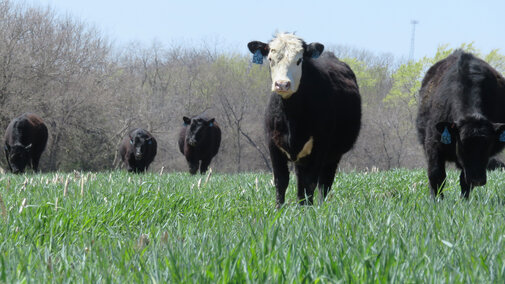Cover Crop Planning
As fall harvest season approaches, crop canopies are starting to open and allowing more sunlight penetration into the ground between rows. Additional sunlight will provide an opportunity for aerial seeding cover crops like oats, wheat, triticale and cereal rye. Generally, aerial seeding occurs with soybeans when the maturing plants start senescencing with leaves turning yellow and dropping from the stems.
The upside to aerial seeding is that the cover crops' fall growth may extend three weeks or more. The downside is reduced seed-to-soil contact provided by drilling seeds into stubble fields soon after harvest. So lack of surface moisture during aerial seeding may require doubled seeding rates compared to drilling as compensation for reduced seed germination, thus increasing overall cover crop seed costs.
For drought zones, producers may be hesitant to aerial seed or drill until significant rainfall is forecast. While cereal rye has been successfully seeded as late at Thanksgiving, fall growth is dramatically reduced by delayed seeding. Research indicates that cover crop biomass doubles each successive month that cover crops growth is extended into the fall before temperatures drop.
Cover crops establishment immediately following corn harvest can be a challenge, especially when corn stover residue is heavy. In some cases, baling corn leaves, husks and stalks will allow better drilling conditions for establishing cover crops. However, this practice is risky if irrigation is not available or droughty conditions prevail.
Also, growing cover crops will improve soil health since live soil microbes require living roots as their food source. So, even later planted cover crops will provide soil health benefits like building soil carbon. During drier falls, cover crop stand establishment is risky, especially when irrigation is not available and rainfall and stored soil water are in short supply.
Nitrate Management for Grazing
While dry conditions can result in high nitrates in annuals, drought isn’t the only thing that may cause nitrate issues. Shade, frost, hail and herbicide damage can all contribute to high nitrate levels. Grazing forages that have high nitrates can be successful, but how it is done can be the difference in life or death.
Grazing growing cover crops or annual forages with higher nitrates is possible because the fresh forage releases nitrates into the rumen slower than a dry forage like hay. Some specific bacteria can also use the high energy to utilize the nitrates directly. Allowing these microbes to adapt gradually to higher diet nitrate levels is critical to the ability to safely handle otherwise toxic levels later on. Grazing aids in this as the slower rate of dry matter intake on fresh forages allows microbes to better keep up with incoming nitrate amounts. That being said, grazing is still a calculated risk.
To minimize risk, make sure cattle are turned out full, with plenty of water, and consider using lower risk cattle such as stockers. Adapt the animals slowly by starting in the lowest nitrate fields first or stocking lightly and avoid force-grazing of the lowest portions of the plant where nitrates are more highly concentrated. Another consideration is to supplement energy in the diet, like low amounts of grain, while adapting cattle so that the rumen microbes can convert the nitrate into bacterial protein more efficiently.
Testing Hay Quality
Do you know the quality of the hay that you harvested this past season? It is important to know how much protein and energy your cows will get when you start feeding, or how much supplement to feed. This may be especially important this year with haying delayed in many areas because of weather or hay that was rained on before baling.
Maybe the most important step in sampling hay is deciding which bales and stacks should be included in each sample. Ideally, each sample should include only bales that were produced under similar conditions.
Obviously, the place to start grouping is to separate different types of hay, like alfalfa, CRP, cornstalk or meadow hay. But each cutting of hay probably is different from the other cuttings also, so there is another separation. And no two fields or meadows are ever exactly the same, especially if they were cut more than several days apart — this makes another grouping. And what if part of the field was rained on before it was baled? The hay made without rain damage will likely be different from hay with rain damage.
After you’ve made all these separations — which could result in quite a few groups of similar bales — then and only then are you ready to sample. From each group, gather a dozen or more cores from different bales or stacks and combine them into one sample. Be sure to use a good hay probe that can core at least 12 to 18 inches into the bale.
Finally, send these samples to a certified lab for tests of crude protein and energy content. If you had drought conditions this past year, testing any annual forages or salvaged dryland crops for nitrates is a good idea.
Then use this information to feed your cattle as profitably as possible.

